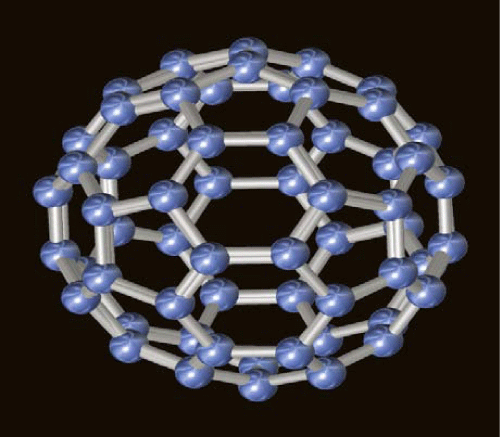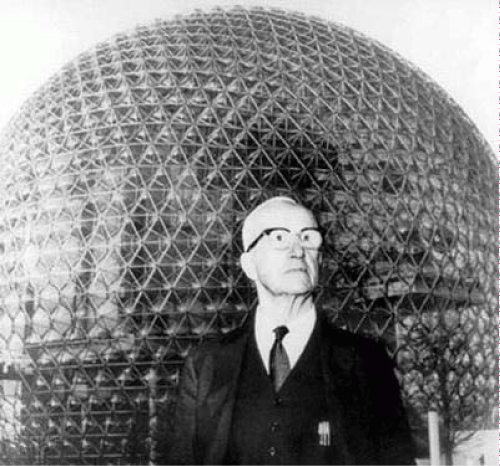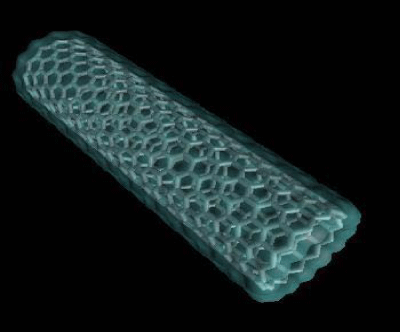| Research Article |
Open Access |
|
| Anuraag Boddupalli* |
| Manipal Institute of Technology, India |
| *Corresponding author: |
Anuraag Boddupalli
Manipal Institute of Technology
576104, India
E-mail: anuraagboddupalli@gmail.com |
|
| |
| Received October 15, 2012; Published October 29, 2012 |
| |
| Citation: Boddupalli A (2012) Building Super Structures through “Buckyballs and Buckytubes”. 1:396. doi:10.4172/scientificreports.396 |
| |
| Copyright: © 2012 Boddupalli A. This is an open-access article distributed under the terms of the Creative Commons Attribution License, which permits unrestricted use, distribution, and reproduction in any medium, provided the original author and source are credited. |
| |
| Abstract |
| |
| Fullerenes or buck series of hollow carbon molecules that form either a closed cage (“buckyballs”) or a cylinder (carbon “nanotubes”) represent an exciting group of nanomaterials which have a beauty and elegance that excites the imagination of scientists and nonscientists alike, as they bridge aesthetic gaps between the sciences, architecture, mathematics, engineering, and the visual arts. Since the discovery of fullerenes in 1985, structural variations on fullerenes have evolved well beyond the individual clusters themselves. Their tremendous significance is related to their unique chemistry, super conductivity, and their technological applications, especially in materials science, electronics, and nanotechnology. Researchers are now slowly unraveling the multifaceted attributes of these molecules for improving society and environment. |
| |
| Keywords |
| |
| Carbon; Geodesic dome; Fullerenes; Nanotubes; Nanomotors |
| |
| Introduction |
| |
| Nanotechnology represents a subject which is a synthesis of different sciences and technologies at the nanometer scale. In other words, it involves a different approach to the way we arrange and rearrange matter, which in turn can be harnessed to develop need based technologies. Until 1985, graphite and diamond were believed to be the only naturally occurring forms of carbon. In the year 1902, seven year old Buckminster Fuller, like all his other classmates was given a set of toothpicks and peas to design whatever he wanted in the class. The objective of that exercise was to judge the creativity and aptitude of the child, but it took several years for people to realize the immense significance of the truncated icosahedron structure that little Buckminster had made (Figure 1). Indeed at first glance, it looked as if he had tried to model his design to make a ball like structure from the straight toothpicks, but this very structure was much more. Several years later, scientists understood that such a structure was one of the most stable freestanding designs that man had ever created. And that too from a young boy, who had trouble with geometry, being unable to understand the abstraction necessary to imagine that a chalk dot on the blackboard represented a mathematical point or that an imperfectly drawn line with an arrow on the end was meant to stretch off to infinity. This man, Richard Buckminster Fuller went on to become one of the greatest scientific thinkers of all times. He gave to the world the concept of Geodesic Dome, Ephemeralization and Spaceship Earth. The most famous example of Geodesic dome being the shiny spherical structure is the Epcot Center at Disneyland in Florida, USA (Figure 2). On 4th September, 2010, Google used an interactively rotatable fullerene C60 as the second 'o' in their logo to celebrate the 25th anniversary of the discovery of the fullerenes. |
| |
|
|
Figure 1: A buckminsterfullerene or a ‘Buckyball’ showing inter-atomic linkages. |
|
| |
|
|
Figure 2: Buckminster Fuller standing in front of his design of the Epcot dome in Florida, USA. |
|
| |
| What are fullerenes? |
| |
| Fullerene is another allotrope of carbon just like diamond and graphite. Allotropes are those having the same chemical formula but varying physical structures. So what are Buckyballs, or Buckminsterfullerenes? The name ‘Buckyballs’ was given to spherical fullerenes as they resembled the balls used in soccer or association football, whereas the cylindrical fullerene structures are called ‘Buckytubes’ (Figure 3). In terms of structure, fullerenes resemble the graphite stacks more than they resemble diamond as fullerenes too have hexagonal shaped rings; the only difference is that fullerenes also have pentagonal rings in their stacks. They are simply allotropes of Carbon with the formula C60 and a cylindrical structure, forming spherical molecules. They can be categorized as Single Walled and Multi Walled Nanotubes and were first discovered in 1952 by L. V. Radushkevich and V. M. Lukyanovich who published clear images of 50 nanometer diameter tubes made of carbon in the Soviet Journal of Physical Chemistry. But the bulk of work done in analyzing their properties was done by Sumio Iijima of NEC (a MultiNational Company based in Japan) in 1991. They were first prepared in 1985 by Kroto H et al. [1]. Kroto and group were awarded the 1996 Nobel Prize in Chemistry for their role in the discovery of buckminsterfullerene and the related class of molecules, the fullerenes. The name is homage to the genius Richard Buckminster Fuller, whose geodesic domes it resembles. Buckminsterfullerene was the first fullerene molecule discovered and it is also the most common in terms of natural occurrence, as it can be found in small quantities in soot from chimneys, etc. |
| |
|
|
Figure 3: A buckytube showing the hexagonal stacking of carbon atoms. |
|
| |
| The Structure of buckminsterfullerenes can be illustrated by their salient features |
| |
| 1. The structure of a buckminsterfullerene is a truncated icosahedron made of 20 hexagons and 12 pentagons, with a carbon atom at the vertices of each polygon and a bond along each polygon edge. |
| |
| 2. The Van Der Waals diameter of a C60 molecule is about 1.01 nm. |
| |
| 3. The nucleus to nucleus diameter of a C60 molecule is about 0.71 nm. |
| |
| 4. Its average bond length is 1.4 angstroms. Each carbon atom in the structure is bonded covalently with 3 others. This implies that there is an electron free on each carbon atom (as carbon has electronic configuration of 2 and 4; hence, it would need one more bond in order to attain complete stability of 8 electrons in the outermost shell) making it a very good conductor of electricity. |
| |
| Significance of buckyballs and buckytubes |
| |
| These molecules have very unusual properties, which are valuable for nanotechnology, electronics and other fields of materials science and technology. In particular, owing to their extraordinary thermal conductivity, mechanical and electrical properties, carbon nanotubes find applications as additives to various structural materials. |
| |
| Some of their properties are listed below: |
| |
| 1. They are the strongest and stiffest materials yet discovered in terms of tensile strength and elastic modulus. |
| |
| 2. Standard single walled carbon nanotubes can withstand pressures up to 24 GPa. |
| |
| 3. The bulk modulus of super hard phase nanotubes is 462 to 546 GPa, even higher than that of diamond (420 GPa for single diamond crystal). |
| |
| 4. As multi-walled nanotubes are concentric cylinders of nanotubes, they exist in such a way, that they slide perfectly inside the larger shells with very less friction and produce perfect linear bearing. |
| |
| 5. Multiwalled carbon nanotubes with interconnected inner shells show superconductivity with a relatively high transition temperature Tc=12 Kelvin. Here Tc is the Critical Temperature. |
| |
| 6. Measurements conducted by Kim and coworkers (2006) showed that a single-wall carbon nanotube (SWNTs) has a roomtemperature thermal conductivity about 3500 W/(mK) and over 3000 W/(mK) for individual multi-walled carbon nanotubes [2]. |
| |
| For the past decade, the chemical and physical properties of fullerenes have been a hot topic in the field of research and development, and are likely to continue to be for a long time. As the range of applications of fullerenes is vast; as additives for Armor reinforcement to anti-microbial agents for medicinal purposes, it has become essential to study all the facets of this unique structure in order to apply them more effectively. But as the complete understanding of the properties of fullerenes requires extensive knowledge of chemistry and chemical instrumentation, an in-depth understanding of their useful and problematic features is essential. |
| |
| They have been known to be stable, but not totally unreactive. Other atoms can be trapped inside fullerenes to form inclusion compounds known as endohedral fullerenes. These fullerenes are known to show superconductivity and heightened hardness and tensile strength. They are also inherently chiral (having all four bonds associated with different ligands). Fullerenes are hence the hot topic of research and work is being conducted all over the world to discover more properties of these carbon allotropes to create superstructures-structures that can withstand gigantic levels of payload and stress and yet remain intact. In popular culture, the famous science fiction author Arthur C. Clarke in his book 3001: The Final Odyssey had envisioned the use of buckminsterfullerenes to create a superstructure ring around the Earth to protect it from potentially disastrous meteor showers. |
| |
| A lot of scientific research is also being conducted for the use of buckyballs to store gases at nano level to study their properties for nanofluidics though this is still in design stage. It would be of great significance for designing nanoreactors, as fullerenes have been documented in research done by Professor Alex Zettl of University of California Berkeley in 2003, to make the smallest rotational motor due to their perfect linear bearing and alignments in their cylindrical buckytube state. The actuator that Professor Zettl designed is of the size of less than 300 nm. All its components are integrated on to a silicon chip. Low-level externally applied voltages precisely control the operation speed and position of the rotor plate. Repeated oscillations of the rotor plate between positions 180 degrees apart, as well as rotations of 360 degrees, had been demonstrated with no signs of wear or fatigue. Unlike existing chemically driven bio-actuators and bio-motors, their fully synthetic nanometer-scale electromechanical system (NEMS) actuator is designed to operate over a wide range of frequency, temperature, and environmental conditions, including high vacuum and harsh chemical environments. If a series of these nanomotors were to be fabricated within a small strip, it would greatly alter the energy production techniques used so far and also reduce the pressure on fossil fuels consumption [3]. |
| |
| In 2003, a proposal was made by a group of petroleum producing and oil field service companies and the University of Texas at Austin to engage in joint research and development concerning the application of nanotechnology to the exploration and production of oil and gas. The goal of the joint venture, called the Advanced Energy Consortium (AEC), is to develop subsurface nanosensors that can be injected into oil and gas well bores. By virtue of their very small size, these sensors would migrate out of the well bores and into the pores of the surrounding geological structure to collect data about the physical characteristics of hydrocarbon reservoirs. The data collected could enable the more efficient exploitation of hydrocarbon resources and hence avoid a great deal of labour and instrumentation damage. |
| |
| All in all, buckytubes and buckyballs show a great promise as the materials which could usher in the ‘Nano Age’ of our world’s development. An age where we would see highly efficient machines to help us in our daily lives with the help of nano motors etc, where natural and manmade disasters could be averted using nanosenors and nanospores (for oil spills cleaning) placed on the earth’s crust and oceans; and an age where life threatening diseases would be cured with the least amount of pain and suffering. It seems like a very utopian view of the future and possibly a lot to ask for from science alone, but in the words of the famous scientist Albert Einstein, “Imagination is more important than knowledge. Knowledge is limited. Imagination encircles the world”. |
| |
| |
| References |
| |
- Kroto HW, Heath JR, O’Brien SC, Curl RF, Smalley RE (1985) C60: Buckminsterfullerene. Nature 318: 162-163.
- Shi L, Majumdar A, McEuen PL, Kim P (2006) Thermal transport measurements of individual multiwalled nanotubes. Phys Rev Lett 87: 215502-215506.
- Fennimore AM, Yuzvinsky TD, Han WQ, Fuhrer MS, Cumings J, et al. (2003) Rotational actuators based on carbon nanotubes. Nature 424: 408-410.
|
| |
| |



